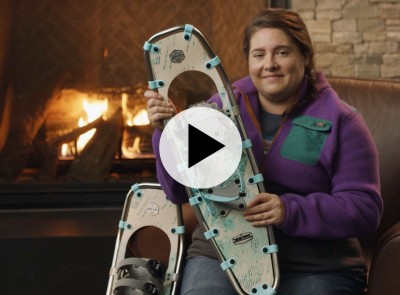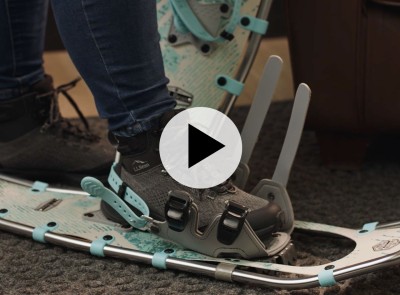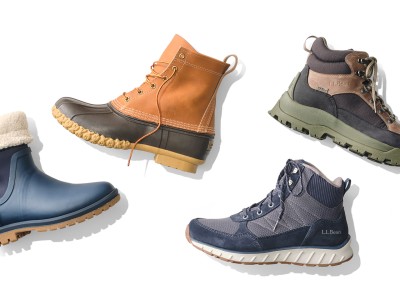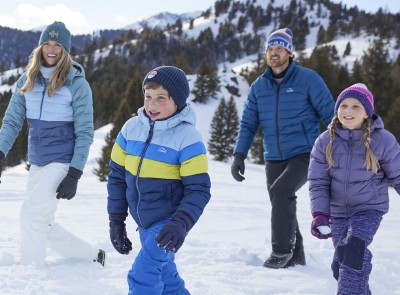(SPEECH)
[00:00:00.00] [MUSIC PLAYING]
(DESCRIPTION)
[00:00:00.00] Logo, L.L. Bean. Title, Ice Skating Tips for Beginners. A woman skates into the center of an ice rink. Caption, Wyoma, Ice Skating Instructor.
(SPEECH)
[00:00:10.24] Hi, there. I'm Wyoma. I'm a figure skating coach who has been teaching beginners of all ages for over eight years.
(DESCRIPTION)
[00:00:16.48] Caption, Family Ice Center, Falmouth, Maine.
(SPEECH)
[00:00:19.45] Today, I'm at the lovely Family Ice Center to go over some of the basics of starting your skating journey. By the time we're done today, we'll have talked about what to wear, what skates to use, how to take your first steps on the ice, and how to stop. I hope by the time we're done, you'll realize that with the right guide, it's easy to glide. Let's skate.
(DESCRIPTION)
[00:00:37.66] Wyoma skates on one foot, then the other across the rink. She holds both arms straight out to the sides and skates backward while watching behind her. She wears an L.L. Bean beanie and jacket.
(SPEECH)
[00:00:47.98] Learning anything is easier if you're comfortable. So before you hit the ice, make sure to outfit yourself properly.
(DESCRIPTION)
[00:00:53.68] Text, Dress for success.
(SPEECH)
[00:00:55.45] For skating, this means layers. It's going to be chilly out on the ice, but you're also going to be moving. Most people are surprised by how much of a sweat they work up while skating around the ice.
(DESCRIPTION)
[00:01:04.74] Wyoma skates sideways and kicks a foot in the air.
(SPEECH)
[00:01:07.73] You want to dress in warm, light layers that can be added or removed according to your ideal comfort. For me, this means wearing a vest that will keep my core temperature up while allowing me to move around the ice.
(DESCRIPTION)
[00:01:18.36] Animation, the fluid in a thermometer rises.
(SPEECH)
[00:01:21.07] All right, let's have the socks talk. You might think you want to wear thick socks because thick socks are great. They're just not so great for skating in. Thick socks will limit your movement and affect your balance.
(DESCRIPTION)
[00:01:31.79] Wyoma holds up two colorful thin pairs of socks.
(SPEECH)
[00:01:34.90] For your ideal comfort, you want to wear thin socks that are either cotton or wool and are long enough to come up above the top of your skate boot. This will limit any unwanted friction and leave plenty of room for flair.
[00:01:45.73] One handy tip is to wear gloves.
(DESCRIPTION)
[00:01:47.50] She holds up a heavy pair of black gloves.
(SPEECH)
[00:01:50.26] Most gloves or mittens will work. But ideally, you want them to be warm, not too bulky, and water resistant if possible. Not only will gloves keep your hands toasty, they'll also help protect them if you fall. And chances are, when you're first learning, you're going to fall. And it's OK.
(DESCRIPTION)
[00:02:05.09] Small type: We recommend helmets and other appropriate safety gear for younger skaters.
(SPEECH)
[00:02:09.87] It's part of the process. In fact, later, I'm going to show you how to fall properly.
(DESCRIPTION)
[00:02:15.07] Wyoma slides across the ice, leans sideways, and puts one hand down while keeping both feet on the ice. Text, To be continued. Choose the right skates.
(SPEECH)
[00:02:20.64] [RECORD SCRATCHING]
[00:02:23.33] Today, we're going to talk about two of the more common kinds of ice skates-- figure skates and hockey skates.
(DESCRIPTION)
[00:02:28.99] She holds up the black bulkier hockey skate in her right hand and the white figure skate in her left hand.
(SPEECH)
[00:02:34.44] Both will do the job when you're starting your skating journey, but you may find that one is better suited to your needs. We're going to talk about some of the differences between these two types of skates.
[00:02:43.65] Now most rinks offer rental skates. But if you're planning on doing a lot of skating, you might want to invest in a pair of your own.
(DESCRIPTION)
[00:02:50.13] She holds the hockey skate and shows the blade.
(SPEECH)
[00:02:52.77] Hockey skate blades are generally a little shorter and attach directly to the boot. These skates are tailored to quick turns and acceleration. They're even strong enough to protect against flying hockey pucks.
(DESCRIPTION)
[00:03:03.28] A hockey puck hits the skate while she is holding it.
(SPEECH)
[00:03:05.52] Hey, the nets over there!
(DESCRIPTION)
[00:03:07.21] Wyoma holds a figure skate.
(SPEECH)
[00:03:08.84] Figure skate blades are generally a little longer, which means more contact with the ice. This can mean better balance for the beginning skater.
(DESCRIPTION)
[00:03:15.47] She points to the front end of the blade with notches.
(SPEECH)
[00:03:18.15] This nifty thing here is called the toe pick. It's used for jumping and pivoting. You won't use it much as a beginner. When choosing your skates, I always tell people to pick what feels right and what aligns with your goals and dreams for skating.
[00:03:30.87] Now that we've picked the right skates, let's talk about how to put them on properly.
(DESCRIPTION)
[00:03:34.56] Wyoma laces up her figure skate.
(SPEECH)
[00:03:36.94] You're going to have a hard time on the ice if your skates don't fit correctly, so make sure to pick the right size. You can always use a sizing chart to help measure your feet.
(DESCRIPTION)
[00:03:44.90] Chart, column 1, skate size 6 through 10.5. Column 2, US Size 7.5 to 12.
(SPEECH)
[00:03:52.53] But a general rule of thumb is you may need to try on one to one and a half sizes down from your shoe size to find the right fit for you. This can vary from skate to skate depending on who makes it. It's always a good idea to try them on to make sure you have the right fit.
[00:04:07.68] Now that we're ready to go, let's lace them up.
(DESCRIPTION)
[00:04:09.82] Text, How to lace them up.
(SPEECH)
[00:04:11.36] Before sliding your foot in, pull up your pants hem so no fabric is caught between when you lace up. This can cause chafing and discomfort.
(DESCRIPTION)
[00:04:19.24] Step 1.
(SPEECH)
[00:04:20.41] First, you want to make sure you loosen your laces all the way down to the bottom-- enough so that your foot slides in very comfortably. If you've chosen the right size, your foot should go in the boot easily.
(DESCRIPTION)
[00:04:31.53] Step 2.
(SPEECH)
[00:04:32.64] Now pull the tongue up and make sure it's fully extended.
(DESCRIPTION)
[00:04:35.60] Wyoma starts tightening up the laces, starting at the bottom.
(SPEECH)
[00:04:39.30] Time to start lacing.
(DESCRIPTION)
[00:04:40.30] Text, Step 3.
(SPEECH)
[00:04:42.04] For the lower laces by the toe, pull them tight enough to make sure they are snug. As you work up the middle of your skates, pull the laces tighter.
(DESCRIPTION)
[00:04:50.15] Step 4.
(SPEECH)
[00:04:51.22] This is where we want our laces to be the tightest. Just be mindful of your comfort as too tight can cause discomfort at the top of your foot.
(DESCRIPTION)
[00:04:59.10] Step 5, put a bow on it.
(SPEECH)
[00:05:00.89] When you're done and they feel snug, put a bow on it. If your laces are too long on the ends, don't wrap them around the top. Simply tuck the remains into the tops of your skates.
[00:05:10.37] All right, now that we've got our skates on, it's time to hit the ice and learn some skating techniques right after I have my hot cocoa.
(DESCRIPTION)
[00:05:16.95] A hand pops up and hands Wyoma a mug of cocoa.
(SPEECH)
[00:05:19.75] Thanks.
[00:05:20.44] [MUSIC PLAYING]
(DESCRIPTION)
[00:05:20.47] She gives the hand a high-five, takes a long drink, smiles, and shrugs her shoulders. Text, How to skate. Wyoma glides across the ice with her arms straight out to the sides.
(SPEECH)
[00:05:31.15] Let's learn how to skate. Today, we're practicing in a rink. But these tips would be the same if you were skating outdoors on a lake or on a pond. The only major difference is here we have some boards to provide a little extra support.
(DESCRIPTION)
[00:05:42.60] She places one foot at a time on the ice while holding onto the entrance side panels.
(SPEECH)
[00:05:47.08] Once you first get out on the ice, you want to find a balanced position.
(DESCRIPTION)
[00:05:50.14] She stands with both feet on the ice next to the sideboards.
(SPEECH)
[00:05:53.41] Place your hands out in front of you like they're flat on a table around the middle of your body and bend your knees. You can use the boards to help support you while you're finding your balance.
(DESCRIPTION)
[00:06:01.93] She places a hand lightly on top of the board.
(SPEECH)
[00:06:04.81] The next step is to start taking little marches, barely picking your feet up off the ice. Don't forget to keep those knees bent. This is going to help you get comfortable moving on the ice.
(DESCRIPTION)
[00:06:14.50] Wyoma takes tiny steps across the ice and stays balanced above her skates.
(SPEECH)
[00:06:18.56] Remember this from earlier?
(DESCRIPTION)
[00:06:19.67] Text, How to fall.
(SPEECH)
[00:06:21.36] That's right. It's time to talk about falling.
(DESCRIPTION)
[00:06:23.24] She leans sideways and lands on her bum.
(SPEECH)
[00:06:25.72] Everybody falls when they first learn how to skate. I even fell. What's important is that we know how to fall properly and safely. If you feel like you're losing your balance, bring your arms out in front of you and bend your knees as much as you can so you can get closer to the ice. If this doesn't stop you from toppling over, try to relax and fall over to one side.
(DESCRIPTION)
[00:06:44.11] She slowly leans to the side and sits on her right hip with her hands in front of her.
(SPEECH)
[00:06:48.26] In order to get back up, we're going to roll over to our knees and bring one leg out in front of us, place one of your hands on your knee and the other one down on the ice, preferably gloved, and go ahead and press up to standing.
(DESCRIPTION)
[00:07:00.65] She puts her right leg out in front and pushes down on it with her hand to stand upright.
(SPEECH)
[00:07:04.66] Now that we've got the hang of marching, let's try a glide.
(DESCRIPTION)
[00:07:07.12] She stands with her knees bent and her hands up in front of her.
(SPEECH)
[00:07:10.14] Take a couple of steps to get some speed and then let your feet come together and slide across the ice. It should look something like this-- march, march, march, glide, march, march, march, glide.
(DESCRIPTION)
[00:07:20.49] She takes three steps and puts her feet together with her knees bent to glide.
(SPEECH)
[00:07:24.00] Now that we've got the hang of gliding on two feet, if you want to try getting your balance on one foot, you can try a one-foot glide. Start with a couple marches, do a two-foot glide, and then lift the toe up to the heel of your skating foot and balance for as long as you can.
(DESCRIPTION)
[00:07:38.09] She takes a few steps, lifts her left foot up slightly, takes a few steps, and lifts her right foot up slightly, toe facing down.
(SPEECH)
[00:07:45.50] Now that you've got the hang of gliding, it's time to try a couple other learning techniques. Something I really like to teach all my students is called the rocking horse. You're going to start with your heels together and your arms out.
(DESCRIPTION)
[00:07:55.46] Her toes face outward.
(SPEECH)
[00:07:56.99] Go ahead and bend your knees and try to make a small circle with the inside of your skates to bring your toes together.
(DESCRIPTION)
[00:08:02.22] She pushes her feet wide and then brings them back together.
(SPEECH)
[00:08:05.37] Keep those knees bent and bring your heels together so you can go back. So we go toes together, heels together.
(DESCRIPTION)
[00:08:12.67] Toes together move forward. Heels together move backward.
(SPEECH)
[00:08:16.88] Once you've got the hang of that, we can try something called swizzles, which is a really fun way to move across the ice. We're going to start with our heels together the same way, bend your knees, and bring your toes together. Instead of going back, keep going forward on this one-- so toes together, heels together.
(DESCRIPTION)
[00:08:32.77] The skates move in and out to move forward.
(SPEECH)
[00:08:35.55] It's time to try pushing off of the inside part of our skate. This is called stroking, and it's a great way to move across the ice.
(DESCRIPTION)
[00:08:41.53] She glides on her left foot and pushes off with her right toe. Then glides on her right foot and pushes off with her left toe.
(SPEECH)
[00:08:48.01] Start by bringing your feet together and bending your knees and pushing off the inside part of your blade. You want to bring your feet back together after each stroke. So it goes push, feet together, push, feet together.
(DESCRIPTION)
[00:09:00.01] She alternates left and right.
(SPEECH)
[00:09:02.37] If you're wearing figure skates, try not to push off of your toe pick. The more you do this, the easier it's going to get, and you'll find your natural rhythm.
(DESCRIPTION)
[00:09:10.52] She glides forward smoothly.
(SPEECH)
[00:09:12.34] And look at that, we're skating.
(DESCRIPTION)
[00:09:13.99] Wyoma approaches the boards quickly and slams into them.
(SPEECH)
[00:09:16.82] Now that is how we don't want to stop on the ice. Sometimes we get so excited about learning how to go forward that we forget to take the time to develop proper stopping technique. One of the most basic techniques for stopping on the ice is called a snowplow stop. We're going to learn how to do that while holding onto the boards.
(DESCRIPTION)
[00:09:32.11] She rests both hands on top of the board.
(SPEECH)
[00:09:34.22] You're going to start with your feet together and bend your knees. You want your toes to point slightly in while you press out and scrape the top layer off the ice-- so bend your knees, toes turn in, and push out.
(DESCRIPTION)
[00:09:46.85] Her left foot slides to the left while her right foot slides to the right, she scrapes ice both ways.
(SPEECH)
[00:09:52.11] Once you feel comfortable doing that at the wall, we can take it away and add a little bit of speed.
(DESCRIPTION)
[00:09:56.22] She backs up onto the open ice.
(SPEECH)
[00:09:57.91] You can do a snowplow stop on either two or one foot. So starting here, get a little speed, bend the knees, and stop.
(DESCRIPTION)
[00:10:06.43] She turns both toes facing in, heels out to stop.
(SPEECH)
[00:10:09.50] And one more time with one foot. Get a little speed, bend the knees, and stop.
(DESCRIPTION)
[00:10:14.50] She turns her right toe in, heel pointed to the right to stop.
(SPEECH)
[00:10:17.91] We did it. If you keep practicing, you'll be skating like a star in no time.
(DESCRIPTION)
[00:10:21.92] Wyoma speeds around the ice backward and does some spins.
(SPEECH)
[00:10:25.13] Hey, I want to congratulate you. A lot of people want to learn how to ice skate and they never do. I guess they just get cold feet. Oh, I bet it's time for me to get off the ice.
(DESCRIPTION)
[00:10:33.78] The Zamboni ice resurfacer drives onto the rink.
(SPEECH)
[00:10:36.42] That's it for me today. For more how to videos like this one, go to the Get Outside Guide at llbean.com.
[00:10:42.63] [MUSIC PLAYING]
(DESCRIPTION)
[00:10:42.67] Wyoma smiles and leaves the ice rink.
[00:10:46.87] Text, For more ways to make getting outside easy, visit LL Bean dot com slash outside.
[00:10:54.97] Wyoma glides by, skating backward.








